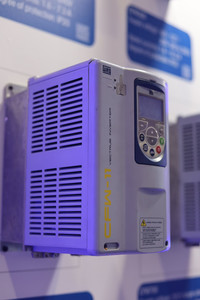
 |
Charlotte Stonestreet
Managing Editor |
| Home> | MACHINE BUILDING & ENGINEERING | >Power Supplies | >The hidden impact of harmonics |
The hidden impact of harmonics
05 December 2023
Davis Strain explains why it is crucial to manage the level of harmonics in the power system and how harmonic filters are a critical solution

IN VARIOUS industries, alternating current (AC) power sourced from the grid propels a wide array of equipment such as motors, fans and pumps. To precisely control their speed, we rely on inverters, also known as variable frequency drives (VFDs) or variable speed drives (VSDs). These devices effectively modulate power but, in doing so, they generate additional harmonic frequencies.
Harmonics occur when additional frequency components, multiples of the fundamental frequency – which is either 50 hertz (Hz) or 60 Hz, depending on the region – distort a sinusoidal signal. Harmonics introduce extra frequencies in addition to the original waveform and, along with their multiples, could be more simply understood as being "undesirable frequencies."
The most obvious symptom is increased power consumption, and therefore higher energy bills. The harmonic frequencies draw more power without providing useful work to the system. Beyond short term energy use, prolonged exposure to harmonics can result in excessive damage from overheating and ultimately lead to poor power quality across the system, potentially causing damage to electronic components and reducing their lifespan.
When discussing temperature increases, it's crucial to note that Eddy currents and the Skin Effect play a pivotal role. Eddy currents, a side effect of harmonics, also contribute to increased losses in the core of the equipment, especially at higher frequencies. They can also lead to the Skin Effect, a phenomenon that causes the alternating current to concentrate on the external layer — or outer surface — of the conductor, typically a wire or component made of copper. The Skin Effect leads to resistive (I²R) losses, due to the conductor’s inherent resistance to the flow of electric current and, consequently, heat.
Armed with this understanding, we can focus on mitigation and optimisation to ensure the reliability and efficiency of our electrical infrastructure.
Reducing harmonics
Mitigating harmonics typically involves the use of harmonic filters. They are electronic components designed to attenuate specific frequencies generated by non-linear loads — devices that draw fluctuating, non-sinusoidal currents from the power source, causing harmonic distortion and potential issues in electrical systems.
By selectively attenuating these unwanted harmonics, filters help maintain a cleaner and more stable power supply in the electrical system. This minimises disruptions and potential damage caused by harmonic distortions.
Let’s look at how mitigating harmonics would be applied in an industrial automation system. Technidrive is a UK and Ireland distributor for Hitachi and WEG VSDs, and supported its partners in designing and implementing a complete automation system that would optimally combine mechanical and electrical performance.
The system included WEG’s W22 super premium efficiency motor controlled by a CFW-11 VSD. The supply and design of the complete project comprised the motor and gearbox specification, the electrical control panel design and build, PLC and HMI programming and commissioning, and the setup and programming of the inverter.
Within this setup, harmonic filters are used alongside an AC inverter drive to reduce undesirable harmonics in the network. An AC inverter drive is an electronic component that selectively attenuates specific frequencies generated by non-linear loads. These filters act like barriers, allowing desired frequencies to pass while blocking or reducing unwanted harmonics.
By incorporating these filters, the inverter ensures that the electrical system receives a cleaner power supply, which minimises disruptions and potential power instabilities or damage caused by harmonic distortions. This contributes to a more efficient and reliable operation of the electrical infrastructure.
Harmonics may often lurk in the background of our electrical systems, and exert a significant influence on their functionality. However, it is by understanding and addressing harmonics that we can maintain the integrity of electrical systems. Through tailored solutions and comprehensive approaches, we can effectively manage and mitigate the disruptive potential of harmonics, ensuring the reliability and efficiency of our electrical infrastructure.
David Strain is technical director Technidrive
Key Points
- Inverters effectively modulate power but in doing so generate additional harmonic frequencies
- Harmonic frequencies draw more power without providing useful work to the system
- By selectively attenuating harmonics, filters help maintain a cleaner and more stable power supply
- Disinfection robots help fight coronavirus
- Jeremy Hadall appointed Visiting Professor at Cranfield University
- Using AI to create safer cars
- Autonomous patrolling security robot
- Monetise unused spare parts
- It's time to pack smarter
- UK cyber security sector worth £8.3b
- Digital adoption critical for an enterprise-led recovery
- Smart factory in practice
- National Engineering & Construction Recruitment Exhibition



















